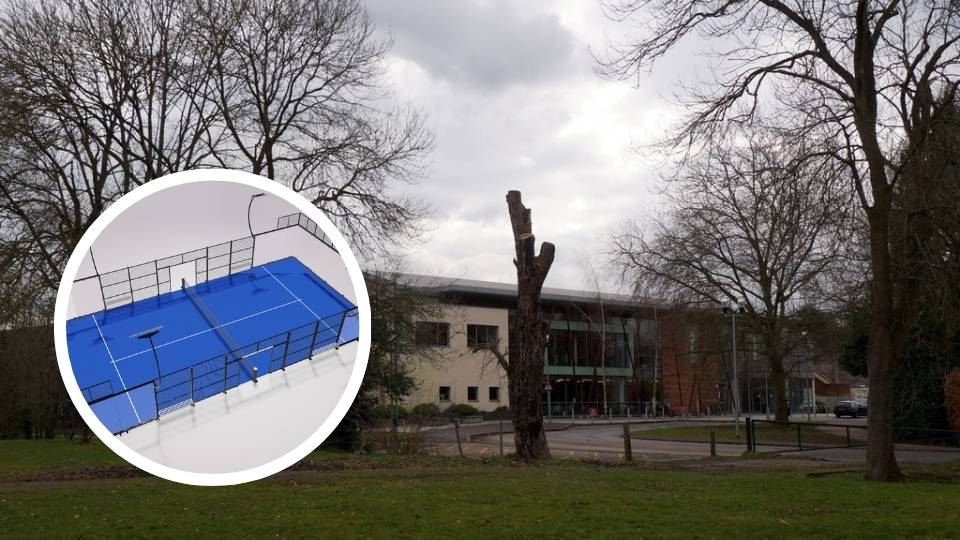Get a free no-obligation quote for Padel Court installation at your sports facility from our team today.
We deliver and install padel courts for a variety of clients, including:
- Tennis clubs and academies
- Sport and leisure centres
- Hotels and luxury resorts
- Golf clubs
- Condominiums
- Stand-alone padel clubs
- Private clients
- And more!
As one of the leading Padel Court distributors in the world, we have a skilled and expert team to ensure your Padel Court is set up according to the highest benchmarks, using top-quality materials and cutting-edge equipment.
We are committed to quality padel courts, safe and timely construction, affordable pricing, and excellent customer service.
Key Factors to Consider Before Buying Padel Courts
There are a whole host of factors you need to consider before committing to a padel court installation.
Which is why speaking to a professional to get all the information you need, answer any question you have, provide a quote and advise you on funding options is the way to go.
You should consider how big a court is, what kind of courts you want, how much space you have, and whether it’s going to be indoor or outdoor – which poses another set of questions for you to ponder.
Padel Court Dimensions – Court Size
Padel courts are 20m long, 10m wide.
The back-walls are 4m high, and the side walls are 3m high.
In feet, that’s 66ft L, 33ft W, 13ft back-walls, and 10ft side-walls.

How Much Space Do You Need?
In total, you would need a rectangular area that’s at least around 16 meters in width and 26 meters in length to accommodate a standard padel court with the necessary safety zones.
To ensure the safety and proper playability of the court, you need additional space around the court, often referred to as the “run-off” area or “safety zone.”
This space is important to allow players to move freely, avoid collisions, and retrieve balls effectively.
Do You Need Planning Permission?
To construct a padel court, you will need planning permission from your local government authority.
Indoor or Outdoor?
You need to decide whether you want indoor or outdoor padel courts. Each have their own unique pros and cons.

Indoor Courts
Pros:
Not affected by weather
Consistent playing conditions
Comfort
Cons:
More expensive
Need a large indoor space
Outdoor Courts
Pros:
Lower initial cost
Natural lighting
Not limited by vertical space
Cons:
Weather dependence
Higher maintenance costs
What About Floodlights?
Outdoor courts will likely require floodlights if you want people to be able to play during the winter months or in the evenings so make sure to budget for these.
Do You Need a Roof Cover?
To enable players to play in rainy weather on your outdoor courts, you should consider getting roof covers.
Especially if your country is prone to poor weather conditions.

How Much Height is Needed for an Indoor Court?
A common guideline for indoor padel courts is to have a ceiling height of at least 7 meters (approximately 23 feet) above the playing surface.
This height allows for comfortable gameplay without players feeling restricted or hindered by the ceiling.
Benefits of Adding Padel Courts to Your Facility
- Padel is the fastest-growing sport in the world and you could be an early provider of courts as demand increases
- Padel attracts all ages as its a lot more forgiving and less demanding than other racket sports
- Women also find the game a lot more accessible with 35% of padel players being female (tennis is only 15%!)
- Courts are regularly more booked than tennis courts, meaning less downtime
What are the Benefits of Padel Over Tennis?
- Less space is required for the courts
- You can build 3 padel courts in the space needed for 1 tennis court!
- You can get funding for padel courts
- It’s easier to learn so it’s likely to become more popular than tennis over the years (it’s already Spain’s second most-played sport)
- It attracts all demographics and skill levels
- It’s more sociable than tennis as it focuses on doubles gameplay and teamwork

We have a full guide comparing tennis and padel courts here.
What’s the Return on Investment?
The return on investment (ROI) for a padel court can vary widely based on several factors, including location, market demand, facility management, pricing strategy, and overall business model.
However, with the funding available and the rapidly growing demand for the sport, facilities that install padel courts will likely break even on their investment within only a few years.
How is a Padel Court Built?
Constructing a padel court involves ten essential steps:
1 – Design and Planning: Before commencing construction, it’s crucial to obtain planning permission for your padel court, whether it’s a new build or a change of use. Conceptual designs and specifications will aid the planning process. Once planning is approved, these details will inform the technical drawings necessary for construction.
2 – Environmental Considerations: Addressing environmental concerns is important in the design phase. This involves incorporating eco-friendly elements into your court, such as choosing environmentally conscious materials for the artificial surface and devising strategies to manage water runoff and floodlighting excess.
3 – Health and Safety: Ensuring a safe and compliant construction site is paramount. Develop comprehensive plans to meet legal requirements and implement safety best practices throughout the construction process.
4 – Earthworks: Precisely executed groundwork is essential to create a solid foundation that guarantees the integrity, performance, and safety of your padel court.

5 – Drainage: Implement the specified drainage system to maintain a court surface suitable for all-weather play.
6 – Sub-Base and Base: Construct the base using carefully selected materials that support effective drainage and enhance the overall court performance.
7 – Concrete Perimeter Ring Beam: A reinforced concrete ring beam is engineered to maintain the structural integrity of the court. This ring beam serves as the attachment point for supporting posts or framed panels using base plates.
8 – Surrounding Enclosure and Rebound Walls: The padel court is enclosed with mesh and glass panels, offering both containment for the playing area and the opportunity to play the ball off the enclosure walls.
9 – Padel Court Surface: You should use sand-dressed artificial turf for the padel court surface. This surface is designed to optimise playability and durability, ensuring a high-quality gaming experience.
10 – Extra Equipment: Include necessary court equipment such as nets, floodlighting, and other specific requirements for the project. This might encompass access pathways, car parks, or additional sports facilities that complement the padel court.
Types of Padel Courts
There are actually quite a few variations of padel courts including:
- Indoor
- Outdoor
- Glass walled
- Solid walled
- Sanded floor
- Carpeted
- Mini
- Instant
There are a lot of options, to get a better understanding of what type of court would work best for your facility we’d recommend you speak to an expert.
Pop-Up Courts
These courts are temporary quick set-up courts with the following benefits and features:
- Polycarbonate walls (see-through, yet 1/3 the weight of glass)
- Sports floor over turf
- Click set up – no need to bolt into the ground
- No groundwork needed
- Mounted in 6-8 hours

How Much Does it Cost to Build A Padel Court?
The typical cost associated with constructing a new padel court generally falls within the range of £55,000 to £80,000 or $70,000 – $100,000 USD.
However, this cost is subject to fluctuations based on several factors, which is a common occurrence in the realm of sports construction projects.
These variables include:
- Extent of groundwork necessities
- Quantity of courts to be erected
- Specified base, sub-base, and drainage system
- Selected artificial turf surface
- Implementation of environmentally conscious measures
- Requisites for floodlighting, fencing, and equipment
Moreover, apart from the core construction of the padel court itself, supplementary efforts may be essential, entailing ancillary equipment and civil engineering tasks.
This might encompass aspects such as establishing access pathways, constructing solid surfaces, configuring roadways, and designing parking lots.
You can also reduce the cost by applying for funding.

Is There Any Funding For Padel Court Construction?
Yes, in the UK, the LTA offers a Quick Access Loan Scheme, providing interest-free loans from £25,000 to £250,000 for organisations to fund padel facilities.
This is in an attempt to grow the game in Britain so take advantage whilst it’s available.
For organisations that aren’t eligible for the quick access loan scheme, private funding options may be available.

How Long Does it Take to Install a Padel Court?
It typically takes 6-8 weeks to construct a court once planning permission and the design process have been completed – which is the most time-consuming part.
How Long Do Padel Courts Last?
If built and installed by professionals, courts last around 20 years before needing renovations.

Padel Court Maintenance Tips
Padel courts are typically equipped with sand-dressed synthetic turf playing areas, a type of surface often found in use for hockey fields.
Just like with any sand-dressed artificial surfaces, consistent upkeep of your padel court is essential to optimse its overall performance, ensure safety, and prolong its longevity.
Maintenance of sand-dressed synthetic turf involves activities like brushing, relieving compaction, managing infill, and clearing away debris.
Additionally, proper care extends to the peripheral components of the padel court, including tasks like securing the bolts on the glass panels.
Many padel court installers offer maintenance aftercare to help you with the more heavy-duty jobs.
Promoting Your New Courts
Once built, you’ll naturally get a lot of people interested in booking your courts but it’s always a good idea to do some additional promotion such as:
- Social Media Posts – with video content
- Promotional Tournaments and Events
- Discounted Coaching Sessions for new players
- Local community partnerships
- Make it easy to book courts on your website
- Local press releases
- Press releases on Padel sites – you can advertise your courts with us here.
By installing padel courts, you’re not alone in promoting the sport and ensuring it reaches its growth potential.
You can read about the plans to grow the sport in Europe here and more specific court information here.
If you’re US-based, you can read more about its expected growth here.

Case Studies and Success Stories
There are tonnes of success stories out there showcasing how installing padel tennis courts at various sports facilities can provide a handsome return on investment.
Here are some of our favourites:
How a Cheltenham Club Capitalised on Padel Tennis Popularity
Get a free consultation and quote from us today, we specialise in building courts in the UK, Europe and the US and are one of the leading court construction providers in the world.






